Morocco is a country that seamlessly blends ancient traditions with modern experiences, making it a captivating destination for travelers. With its rich cultural heritage, diverse landscapes, and vibrant cities, Morocco offers an unforgettable adventure.
From the snow-capped Atlas Mountains to the serene Atlantic beaches, Morocco’s diverse landscapes are as varied as they are breathtaking. The country’s well-preserved historic cities, such as those listed on UNESCO’s World Heritage sites, allow visitors to travel through time while enjoying modern amenities.
Whether you’re drawn to vibrant medinas, stunning beaches, or world-famous architectural wonders, Morocco has something for every kind of traveler.
Key Takeaways
- Discover Morocco’s top destinations for culture, history, and adventure.
- Explore the country’s diverse landscapes and vibrant cities.
- Learn about the unique attractions and cultural significance of each city.
- Get practical travel tips for an unforgettable Moroccan adventure.
- Find out how to make the most of your trip based on your interests and time.
Discovering Morocco’s Diverse Landscapes and Rich Heritage
From the snow-capped Atlas Mountains to the Sahara Desert’s majestic dunes, Morocco’s diverse landscapes are a traveler’s paradise. Within a single day of travel, visitors can experience lush farmlands, towering canyons, and the edge of the desert.
Morocco’s rich history and culture are preserved in its imperial cities, each with its own distinct significance. Marrakech, Fez, Rabat, and Meknes offer unique glimpses into the country’s royal past.
- The country’s diverse landscapes range from mountains to deserts, offering various destinations for travelers.
- Morocco’s culture reflects influences from Berber, Arab, European, and Sub-Saharan African traditions.
- Visitors can experience the vibrant cities and rich history of Morocco.
When planning your visit to Morocco, consider focusing on a few key places to visit rather than attempting to see everything at once. This allows for a more immersive experience in the local culture and history.
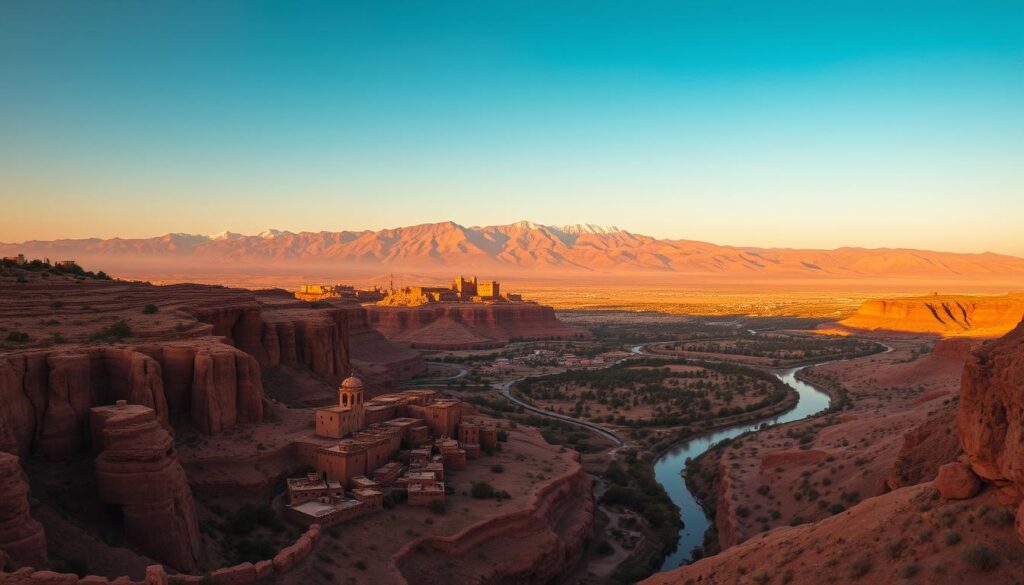
With major European cities just a short flight away, Morocco is an ideal destination for those seeking an immersive cultural experience without extensive travel time.
Marrakech: The Pink City of Romance and Sensory Delights

The vibrant city of Marrakech is a sensory haven, where ancient traditions meet modern luxuries. Marrakech, often called the “Pink City” due to its distinctive rose-hued buildings, is a paradise for travelers seeking a rich cultural experience.
Must-See Attractions in Marrakech
Marrakech is home to numerous iconic landmarks. The heart of the city is Djemaa el Fna, a UNESCO-recognized square that transforms throughout the day. Exploring the old medina of Marrakech is like stepping back in time, with its labyrinthine alleys housing traditional riads and artisan workshops.
The city boasts stunning architectural wonders, including the Koutoubia Mosque with its iconic minaret, the opulent Bahia Palace, and the tranquil Jardin Majorelle, formerly owned by Yves Saint Laurent.
Where to Stay and Eat in Marrakech
Marrakech offers accommodations for every budget, from luxury hotels like Royal Mansour to charming traditional riads in the medina. Visitors can experience authentic Moroccan hospitality and architectural beauty in these unique settings.
Day Trips from Marrakech
The city serves as an ideal location for day trips to nearby attractions, including the Agafay Desert for glamping under the stars, the Atlas Mountains for hiking adventures, or the coastal city of Essaouira for a refreshing change of pace.
Fez: A Journey Through Morocco’s Medieval Past
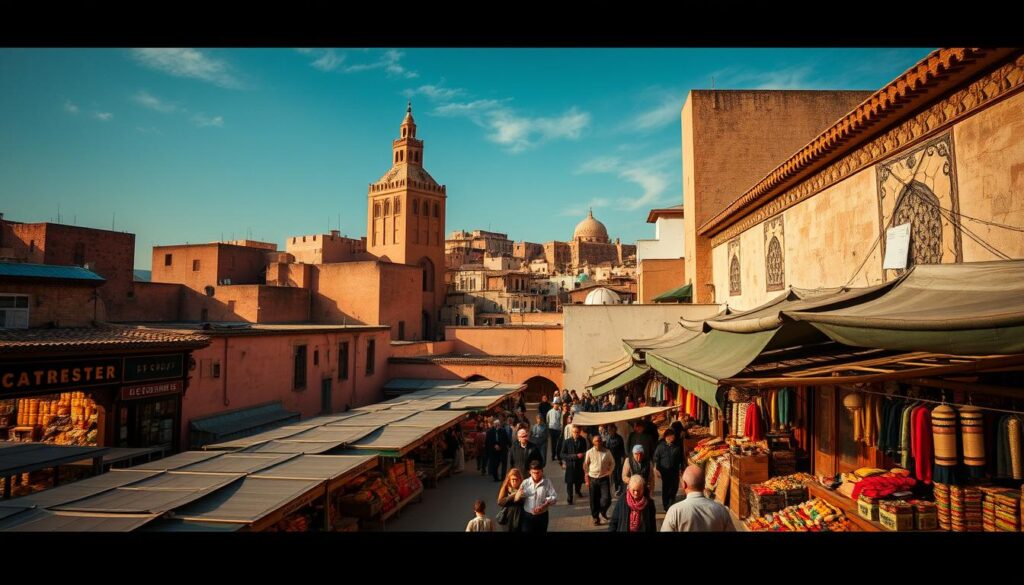
Fez, Morocco’s oldest imperial city, is a living museum of medieval architecture and culture. The city’s medieval character is preserved in its vast, car-free medina, Fes el-Bali, which is one of the world’s largest and most complex urban areas.
Navigating the Ancient Medina
The ancient medina of Fez contains over 9,000 narrow streets and alleyways filled with historic buildings, bustling markets, and artisan workshops. Visitors can easily get lost in the medina’s labyrinthine passages, discovering hidden gems and experiencing the traditional crafts that have been practiced for centuries.
Cultural and Historical Landmarks
Fez is home to numerous historical landmarks, including the ornate Bou Inania Madrasa and the Royal Palace with its magnificent brass doors. The city’s famous tanneries, such as the Chouara Tannery, offer spectacular views of the ancient leather-making process.
Nearby Attractions
A visit to Fez can be complemented by day trips to nearby attractions like the Roman ruins of Volubilis and the holy town of Moulay Idriss. These sites provide additional context to the region’s rich history and architectural heritage.
Fez is a city that embodies the essence of Morocco’s diverse cultural and historical landscape, making it a must-visit destination for anyone interested in exploring the country’s medieval past.
Chefchaouen: The Enchanting Blue Pearl of Morocco
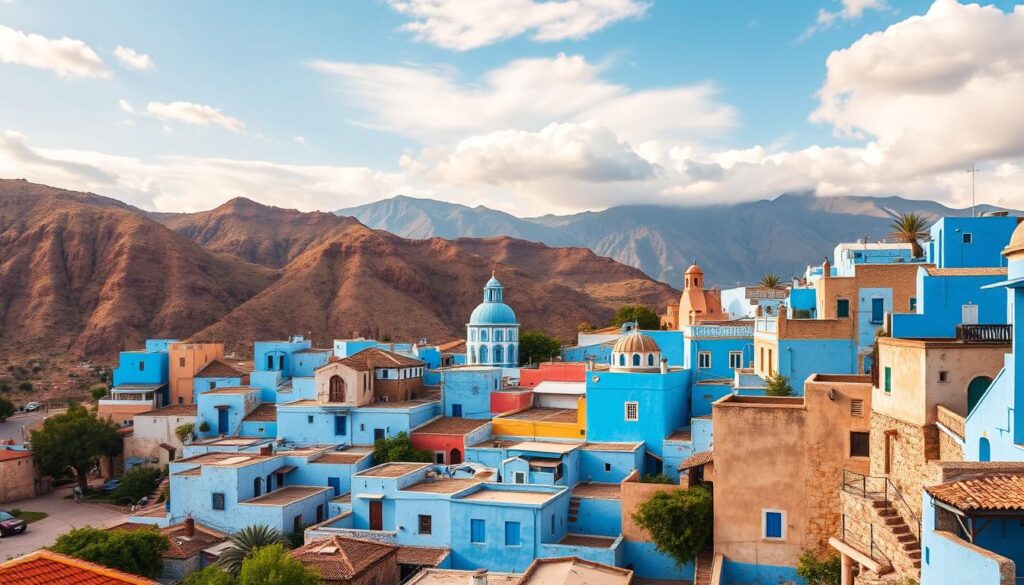
Tucked away in the Rif Mountains, Chefchaouen is a mesmerizing destination that has captured the hearts of travelers worldwide. This charming town is instantly recognizable for its striking blue-washed buildings that create a dreamlike atmosphere unlike anywhere else in Morocco.
Exploring the Blue Maze
Walking through Chefchaouen’s medina feels like entering a different world, where every turn reveals new shades of blue against whitewashed walls, creating endless photo opportunities and a sense of peaceful serenity. The origins of Chefchaouen’s blue houses remain debated, with theories ranging from repelling mosquitoes to symbolizing the sky and heaven.
Outdoor Adventures Around Chefchaouen
Beyond its picturesque appearance, Chefchaouen offers a relaxed vibe that has made it a favorite destination for travelers looking to escape the intensity of Morocco’s larger cities. The area surrounding Chefchaouen provides excellent opportunities for outdoor adventures, including hiking to the Spanish Mosque for sunset views or exploring the nearby Talassemtane National Park. Visitors often extend their planned stay from days to weeks, immersing themselves in the local culture and way of life.
Chefchaouen’s unique character extends to its artisanal products, with local craftspeople producing distinctive woolen garments, woven blankets, and handmade leather goods that make for authentic souvenirs to take home on your trip. Whether you’re looking to relax in a beautiful place or explore new destinations, Chefchaouen is a must-visit city in Morocco.
Essaouira: Where City Meets Beach
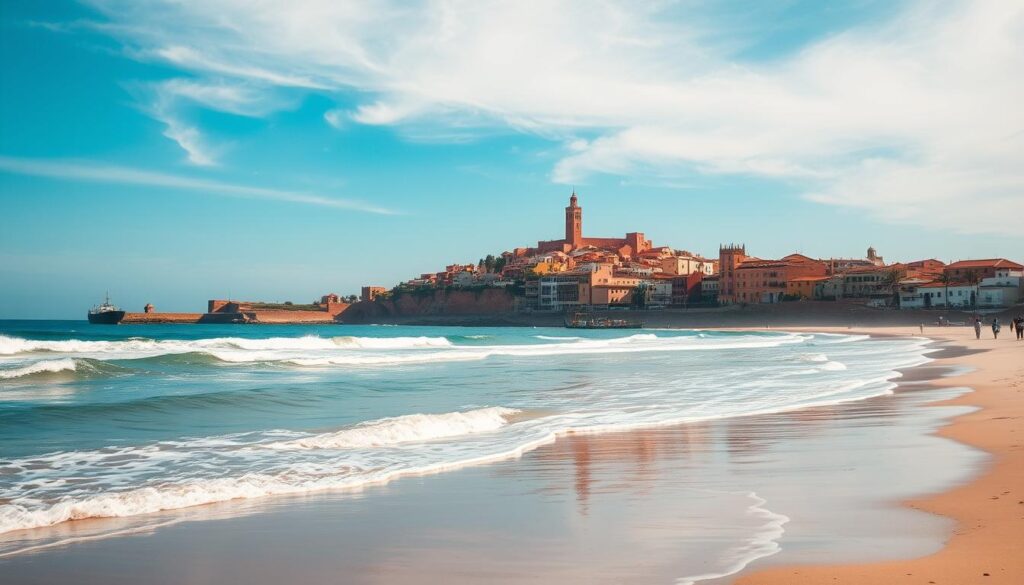
Essaouira, a charming coastal city, offers a unique blend of cultural immersion and beach relaxation. Its UNESCO-protected medina sits just steps away from a sweeping Atlantic coastline that attracts surfers from around the world.
The Historic Medina and Port
The historic port city has a distinctly different feel from inland Morocco, with its whitewashed buildings adorned with blue shutters creating a Mediterranean aesthetic that has attracted artists, musicians, and filmmakers for decades. Essaouira’s working port provides a fascinating glimpse into coastal Moroccan life.
Beach Activities and Water Sports
Water sports enthusiasts flock to Essaouira’s beaches for world-class windsurfing and kitesurfing conditions. Those seeking a more relaxed beach experience can visit nearby coastal villages like Sidi Kaouki.
Arts and Culture
Essaouira comes alive at night with its vibrant music scene, particularly during the annual Gnaoua World Music Festival, celebrating the spiritual music and culture of the descendants of Sub-Saharan African slaves who settled in Morocco.
Merzouga and the Sahara Desert: An Otherworldly Adventure
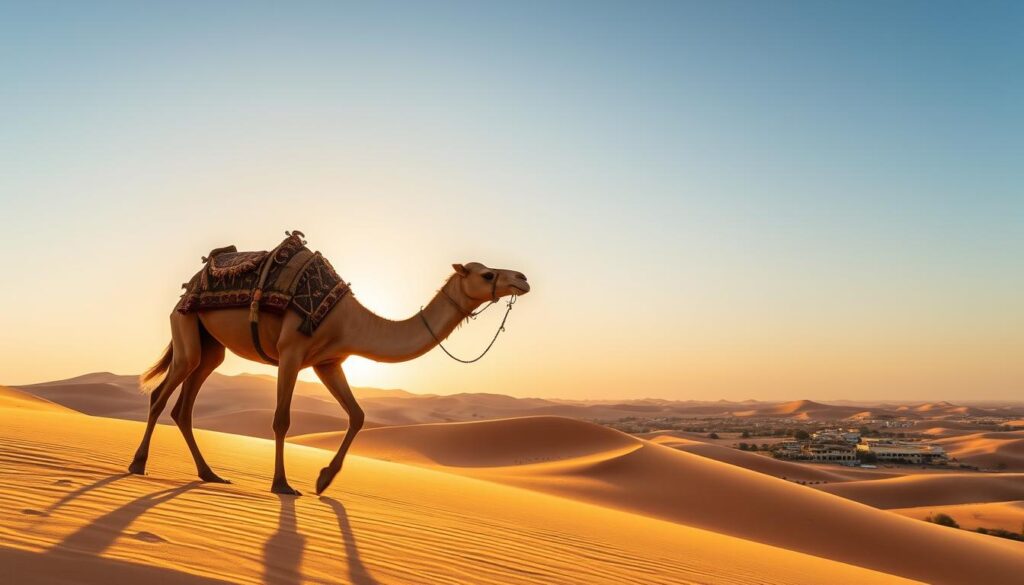
For those seeking an otherworldly experience, Merzouga and the Sahara Desert are a must-visit destination. The journey to this part of Morocco is one that truly feels like stepping into another world, where the endless sea of golden sand dunes creates landscapes that seem almost otherworldly.
Camel Trekking and Desert Camping
A traditional camel trek into the desert offers unforgettable views of the undulating dunes and provides insight into the historic caravan routes that once connected Morocco to Sub-Saharan Africa through the harsh desert terrain. Spending a night in a desert camp beneath the star-filled Saharan sky is a highlight for many visitors.
Stargazing and Cultural Experiences
The absence of light pollution creates perfect conditions for stargazing while Berber guides share stories and music around the campfire. The Sahara is home to Berber villages where visitors can experience traditional desert hospitality and learn about sustainable living in one of the world’s harshest environments.
Adventure Activities in the Desert
Beyond the classic camel treks, the desert around Merzouga offers adventure activities including sandboarding down the dunes, 4×4 excursions to remote areas, and visits to the seasonal Dayet Srji salt lake, which attracts flamingos and other migratory birds.
Rabat: Morocco’s Underrated Capital

Rabat, Morocco’s underrated capital, is a city where ancient traditions meet modern vibrancy. As the capital city since 1956, Rabat offers visitors a more relaxed and less touristy experience than other major cities, blending historic monuments with modern urban life in a way that feels authentically Moroccan.
Historical Sites and Monuments
The city’s most iconic landmark is the Hassan Tower, the incomplete minaret of what was intended to be the world’s largest mosque in the 12th century. It stands alongside the Mausoleum of Mohammed V, a masterpiece of modern Moroccan architecture. The Kasbah of the Udayas, a UNESCO World Heritage site, offers spectacular views over the Atlantic Ocean and the Bou Regreg River, with its Andalusian-style gardens and charming blue and white painted streets within its walls.
Modern City Life
Modern Rabat features wide boulevards, international restaurants, art galleries, and beautiful public beaches like Plage de Rabat, making it a pleasant place to experience contemporary Moroccan city life. History enthusiasts will appreciate Rabat’s archaeological museum and the nearby site of Chellah, which contains both Roman ruins and a medieval Islamic necropolis, showcasing the layered history that characterizes so many places in Morocco.
Tangier: The Gateway Between Continents

Tangier, Morocco’s gateway to Europe, is a city of intriguing contrasts and breathtaking views. Strategically positioned at the meeting point of the Mediterranean Sea and the Atlantic Ocean, Tangier has historically served as a gateway city between Morocco and Europe.
Mediterranean Charm
The city’s storied past as an international zone from 1923 to 1956 attracted artists, writers, and spies, giving Tangier a cosmopolitan character that still permeates its cafes, beaches, and cultural institutions. Tangier’s medina houses a mix of traditional Moroccan homes alongside buildings with distinct European influences, creating a unique cultural blend visible in its architecture and daily life.
From the Kasbah at the highest point of the medina, visitors can enjoy breathtaking views across the Strait of Gibraltar to Spain. The city’s beautiful beaches stretch along both the Mediterranean coast and the Atlantic, offering a range of experiences from bustling urban beaches near the port to more secluded spots perfect for relaxation.
Nearby Attractions
Tangier serves as an excellent base for exploring nearby attractions, including the Caves of Hercules with their Africa-shaped opening to the sea, the blue city of Chefchaouen, and the Roman ruins of Lixus, all accessible as day trips. These destinations offer a mix of natural beauty, culture, and history, making Tangier a great starting point for a variety of adventures.
Best Time to Visit Morocco
The best time to visit Morocco varies significantly based on whether you’re heading to the coast, desert, or Atlas Mountains. Morocco’s diverse geography creates different climate zones.
- Spring (March to May) and fall (September to November) offer pleasant weather, ideal for exploring city attractions and outdoor activities.
- Summer can be extremely hot in inland cities, while coastal areas remain comfortable.
- Winter brings cold temperatures and snow to the Atlas Mountains, perfect for skiing, and pleasant daytime temperatures in the desert regions.
Planning your visit during these optimal periods ensures a more enjoyable experience. Consider the number of days you have and the regions you wish to explore to make the most of your trip to Morocco.

Getting Around Morocco
Traveling through Morocco is facilitated by a range of transportation services, making it simple to explore its many attractions. The country offers diverse options that allow travelers to navigate between cities and explore remote places efficiently.
Rail Network: Morocco’s rail network, operated by ONCF, connects major cities including Tangier, Rabat, Casablanca, Marrakech, and Fez with comfortable and affordable service. The high-speed Al Boraq train between Tangier and Casablanca is particularly noteworthy.
For locations not served by trains, CTM and Supratours operate reliable long-distance bus services. These buses are equipped with air conditioning and have scheduled departures, making it possible to reach beach towns, mountain villages, and desert gateways.
Within cities, petit taxis provide convenient transportation for short trips. These small, metered taxis are specific to each city and identifiable by their different colors. For intercity routes, larger grand taxis can be used, often shared with other passengers.
Rental Cars offer flexibility for exploring Morocco at your own pace, particularly for reaching remote locations or taking scenic drives. However, city traffic can be chaotic, and parking challenging in urban centers.
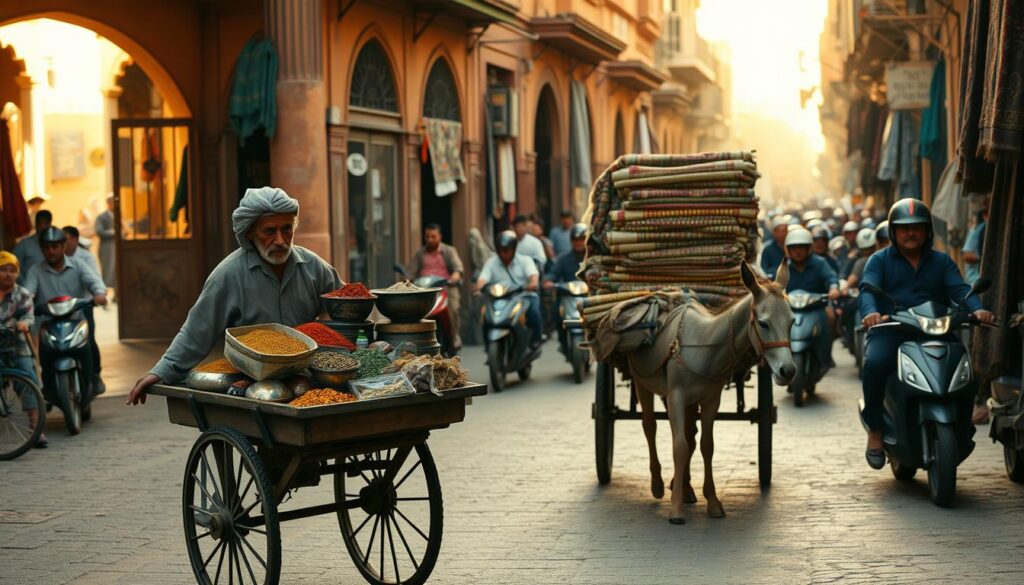
Practical Travel Tips for Morocco
As you prepare for your Moroccan adventure, familiarizing yourself with some practical travel tips will ensure a more enjoyable and stress-free trip.
Cultural Etiquette
Understanding cultural etiquette is essential when traveling in Morocco. Dress modestly, especially for women, and ask permission before photographing people. Respect religious customs, particularly during prayer times and Ramadan.
Safety and Health
Safety concerns in Morocco are similar to those in many popular travel destinations. Stay vigilant in crowded areas, avoid displaying valuable items, and be cautious at night in isolated areas.
Money and Bargaining
The Moroccan dirham is a closed currency. ATMs are widely available, but it’s advisable to carry cash when visiting remote villages. Bargaining is expected in souks; start with 40% of the asking price and negotiate to a mutually acceptable price.
| Tip | Description |
|---|---|
| Dress Modestly | Respect local customs by dressing conservatively. |
| Be Vigilant | Avoid displaying valuables in crowded areas. |
| Bargain Friendly | Negotiate prices with a smile and patience. |
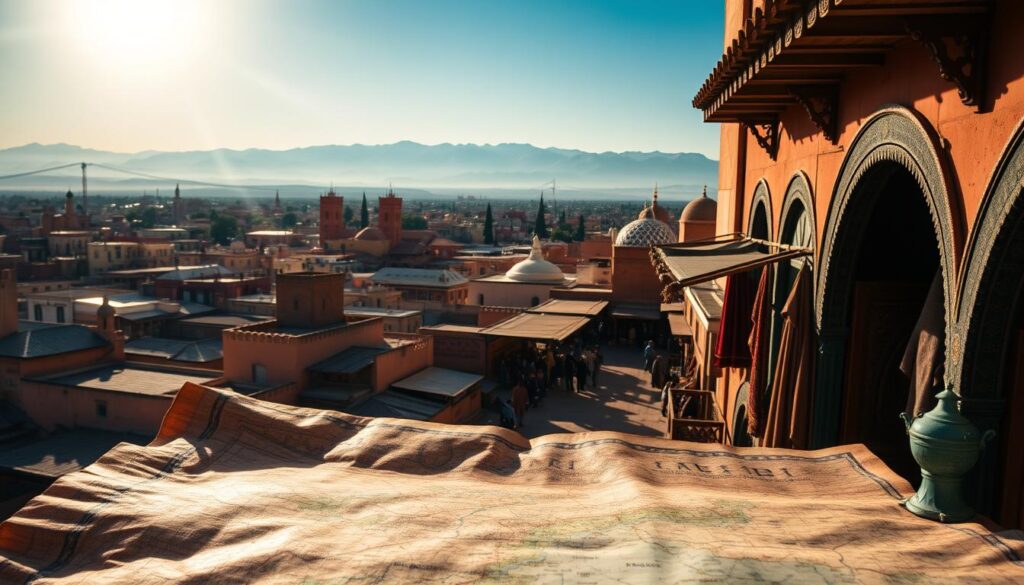
Conclusion: Planning Your Moroccan Adventure
Embarking on a journey to Morocco means immersing yourself in a world of vibrant colors, tantalizing cuisine, and warm hospitality. This extraordinary country offers a diverse array of experiences, from exploring imperial cities and relaxing on serene beaches to trekking through the majestic desert landscapes.
When planning your trip to Morocco, it’s advisable to focus on specific regions rather than trying to cover everything at once. Consider exploring either the northern cities like Tangier, Chefchaouen, and Fez, or the southern route that includes Marrakech, Essaouira, and the Sahara dunes. Leave some room in your itinerary for unexpected discoveries, as Morocco is full of hidden gems waiting to be uncovered.
Whether you’re drawn to Morocco for its architecture, photography opportunities, culinary delights, or outdoor adventures, this captivating country promises world-class experiences. With its rich heritage and welcoming atmosphere, you’ll likely find yourself planning a return visit before you’ve even left the land of mint tea and sweeping sand dunes.